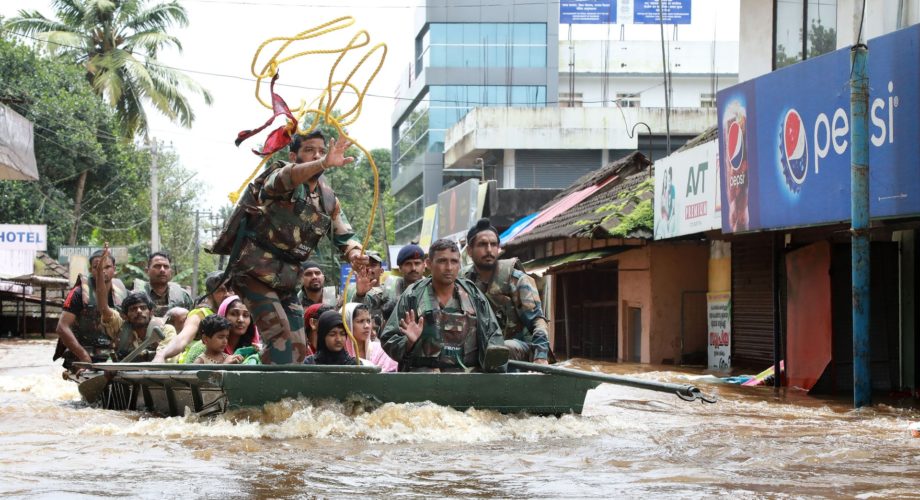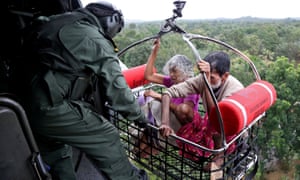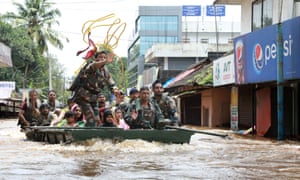
Soldiers evacuate local residents in Ernakulam.
More than 324 people have died in the worst flooding in nearly a century in the south Indian state of Kerala.
Roads are damaged, mobile phone networks are down, an international airport has been closed and more than 220,000 people have been left homeless after unusually heavy rain in the past nine days.
Officials repeatedly revised the death toll upwards from 86 people on Friday morning to more than 300 by the evening as a massive rescue operation reached more flood-hit regions. “Around 100 people died in the last 36 hours alone,” a state official said.
Casualty numbers are expected to increase further, with thousands more people still stranded and less intense though still heavy rain forecast for at least the next 24 hours. Many have died from being buried in hundreds of landslides set off by the flooding.
The Kerala chief minister, Pinarayi Vijayan, said the state was experiencing an “extremely grave” crisis, with the highest flood warning in place in 12 of its 14 regions.
“We’re witnessing something that has never happened before in the history of Kerala,” he told reporters.
The Indian prime minister, Narendra Modi, was on his way to Kerala on Friday evening “to take stock of the flood situation in the state”, he said.
Kerala, famed for its tea plantations, beaches and tranquil backwaters, is frequently saturated during the annual monsoon. But this year’s deluge has swamped at least 20,000 homes and forced people into more than 1,500 relief camps.

People are airlifted to safety.
The toll in Kerala contributed to more than 900 deaths recorded by the Indian home ministry this monsoon season from landslides, flooding and rain.
Rescue workers and members of India’s armed forces have been deployed across the state with fleets of ships and aircraft brought in to save the thousands of people still stranded, many sheltering on their roofs signalling to helicopters for help.
Officials estimated about 6,000 miles (10,000km) of roads had been submerged or buried by landslides and a major international airport in Cochin has been shut until 26 August. Communications networks were also faltering, officials said, making rescue efforts harder to coordinate.
Residents of the state used social media to post desperate appeals for help, sometimes including their GPS coordinates to help guide rescuers.
“My family and neighbouring families are in trouble with flood in Pandanad nakkada area in Alappuzha,” Ajo Varghese said in a viral Facebook post. “No water and food. Not able to communicate from afternoon. Mobile phones are not reachable and switch off. Please help … No rescue is available.”
Another man in the central town of Chengannur posted a video of himself neck-deep in water in his home. “It looks like water is rising to the second floor,” he says. “I hope you can see this. Please pray for us.”
The fate of the man was still unclear on Friday. The state finance minister, Thomas Isaac, tweeted in the afternoon that the last road to Chengannur had washed away before his eyes and the town was cut off.
The water has claimed parts of Cochin, the state’s commercial capital, and was still rising in some areas of the city on Friday, with residents urged to evacuate and guide ropes strung across roads inundated by fast-moving currents.

Soldiers evacuate local residents in Ernakulam.
Meteorologists said Kerala had received an average 37.5% more rainfall than usual. The hardest-hit districts such as Idukki in the north received 83.5% excess rain. More than 80 dams across the state had opened their gates to try to ease the crisis, the chief minister said.